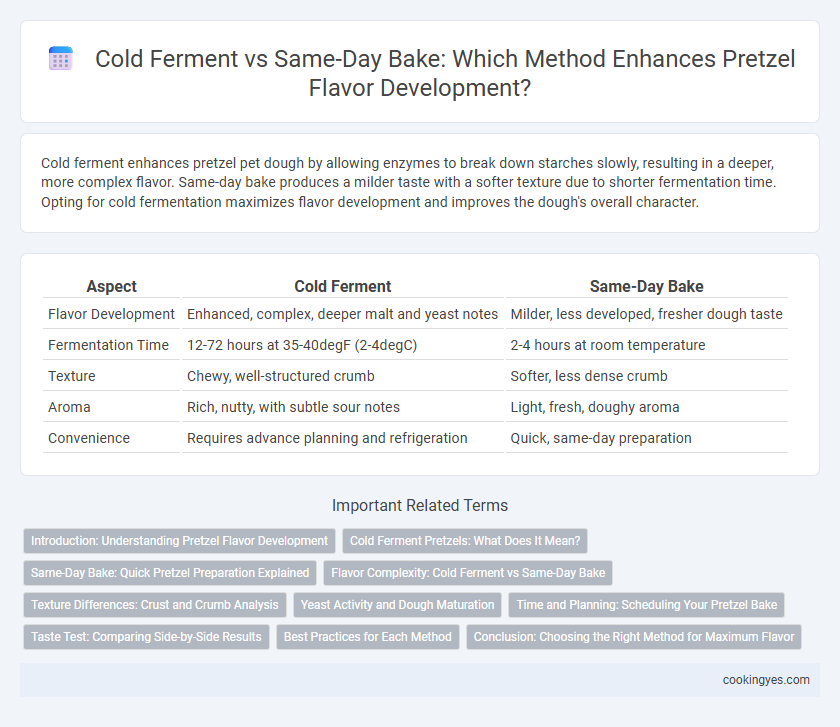Cold ferment enhances pretzel pet dough by allowing enzymes to break down starches slowly, resulting in a deeper, more complex flavor. Same-day bake produces a milder taste with a softer texture due to shorter fermentation time. Opting for cold fermentation maximizes flavor development and improves the dough's overall character.
Table of Comparison
| Aspect | Cold Ferment | Same-Day Bake |
|---|---|---|
| Flavor Development | Enhanced, complex, deeper malt and yeast notes | Milder, less developed, fresher dough taste |
| Fermentation Time | 12-72 hours at 35-40degF (2-4degC) | 2-4 hours at room temperature |
| Texture | Chewy, well-structured crumb | Softer, less dense crumb |
| Aroma | Rich, nutty, with subtle sour notes | Light, fresh, doughy aroma |
| Convenience | Requires advance planning and refrigeration | Quick, same-day preparation |
Introduction: Understanding Pretzel Flavor Development
Cold fermentation enhances pretzel flavor by allowing slow yeast activity over 12 to 48 hours, promoting complex organic acid and alcohol production. Same-day baking relies on rapid fermentation, resulting in a milder, less developed taste due to limited time for biochemical reactions. Extended cold ferment optimizes Maillard reaction precursors and dough maturation, yielding richer aromas and deeper crust color.
Cold Ferment Pretzels: What Does It Mean?
Cold ferment pretzels undergo a slow fermentation process in a refrigerated environment, allowing natural yeast and enzymes to break down the dough gradually. This extended fermentation enhances flavor complexity, resulting in deeper, more robust tangy and malty notes compared to same-day bake methods. The controlled cold temperature preserves dough moisture and improves gluten structure, producing a chewier texture and richer aroma often favored in artisan pretzel baking.
Same-Day Bake: Quick Pretzel Preparation Explained
Same-day bake pretzels offer a rapid preparation method where dough undergoes minimal fermentation, resulting in a softer crust and less complex flavor compared to cold-fermented counterparts. This technique emphasizes efficiency, allowing bakeries to produce fresh pretzels within hours, catering to immediate demand. While flavor depth is reduced, same-day bake pretzels maintain a satisfying chew and golden color due to effective baking and lye treatment processes.
Flavor Complexity: Cold Ferment vs Same-Day Bake
Cold ferment enhances pretzel flavor complexity by allowing extended enzymatic activity, which develops deeper malty and caramel notes. Same-day bake produces fresher, but simpler flavors due to shorter fermentation time and less breakdown of starches and sugars. The prolonged cold fermentation method is preferred for achieving richer, more nuanced taste profiles in artisanal pretzels.
Texture Differences: Crust and Crumb Analysis
Cold ferment enhances pretzel texture by allowing enzymatic activity during slow yeast fermentation, resulting in a thicker, chewier crust and a more open, airy crumb. Same-day bake produces a thinner, crisper crust with a denser, tighter crumb due to rapid yeast activation and shorter proofing time. The extended fermentation in cold cold ferment also improves moisture retention and flavor depth, contributing to a superior texture profile in baked pretzels.
Yeast Activity and Dough Maturation
Cold ferment enhances yeast activity by slowing fermentation, allowing enzymes to break down starches more thoroughly, resulting in better dough maturation and complex flavor development in pretzels. Same-day bake accelerates yeast fermentation, producing a milder, less developed flavor due to limited enzyme activity and dough resting time. Optimizing fermentation temperature and time is key to balancing yeast activity and dough maturation for desired pretzel texture and taste.
Time and Planning: Scheduling Your Pretzel Bake
Cold ferment allows dough to develop complex flavors over 12 to 72 hours by slowing yeast activity, enhancing the pretzel's taste and texture through extended enzymatic processes. Same-day bake requires precise timing and rapid fermentation, producing a milder flavor but enabling quick turnaround, ideal for high-demand settings. Effective scheduling balances fermentation time with production needs to optimize flavor while maintaining consistent output.
Taste Test: Comparing Side-by-Side Results
Cold ferment pretzels develop complex, tangy flavors and a chewier texture due to prolonged yeast activity at low temperatures, enhancing malt and lactic acid notes. Same-day baking produces a milder, sweeter taste with a softer crumb but less depth in flavor. Taste tests consistently reveal that cold-fermented pretzels offer richer, more nuanced flavor profiles preferred by artisan baking enthusiasts.
Best Practices for Each Method
Cold ferment enhances pretzel flavor by allowing enzymes to break down starches and proteins slowly, resulting in deeper Maillard reactions and a more complex, tangy taste. Same-day baking offers a fresher, softer crumb and quicker production but may lack depth in flavor due to shorter fermentation. Best practice for cold ferment involves resting dough at 35-40degF for 12-24 hours, while same-day bake requires precise yeast activation and shorter proofing to maintain texture and mild flavor.
Conclusion: Choosing the Right Method for Maximum Flavor
Cold fermentation enhances pretzel flavor by allowing extended enzymatic activity and complex yeast fermentation, resulting in a deeper, more nuanced taste profile. Same-day baking offers convenience but limits the development of aromatic compounds and texture complexity. For maximum pretzel flavor, cold fermenting dough overnight is the optimal method to achieve superior taste and chewiness.
Cold ferment vs same-day bake for flavor development Infographic

 cookingyes.com
cookingyes.com